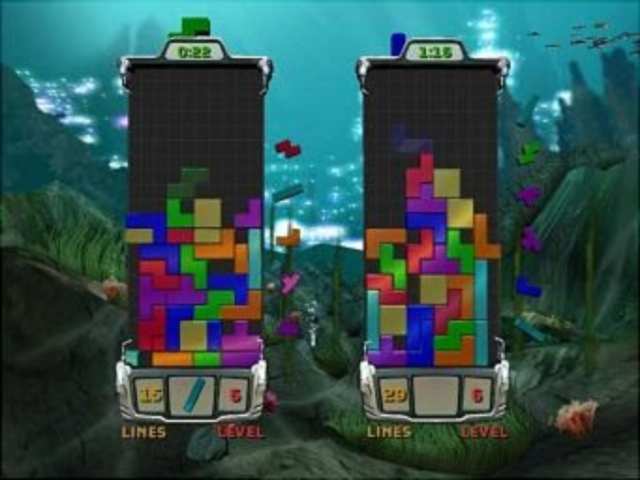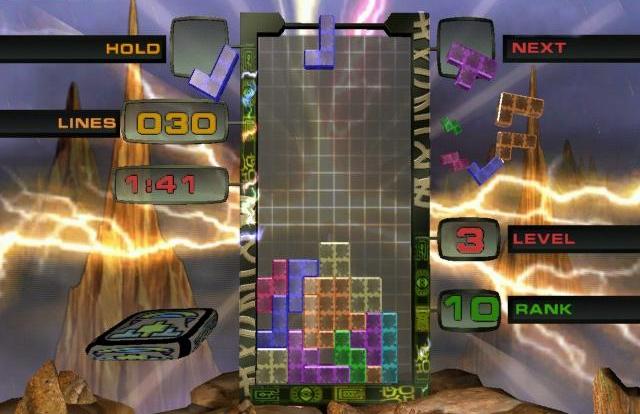Overview

Tetris Worlds is a falling-block puzzle game developed by Blue Planet Software (along with 3d6 Games for the GBA version and Radical Entertainment for the GC and Xbox versions) and published by THQ (with the Japanese version co-published by Success) for the PlayStation 2, GameCube, Xbox, PC, and Game Boy Advance throughout late-2001 and 2002.
The third Tetris game from Blue Planet Software (after The Next Tetris and The New Tetris), Tetris Worlds brings the classic puzzle game to sixth-generation game consoles while featuring six different Tetris variations, four-player multiplayer, and a Story Mode involving a block-like alien species known as the "Minos", who work to colonize six distant planets using special teleportation devices as their homeworld's star system is close to collapsing.
It is notable for standardizing several gameplay elements of the official series moving forward, including its rotation system (which now utilizes "wall kicks" for attempting a rotation in an obstructed area). It also introduces the controversial "Easy Spin" (which delays locking a piece indefinitely as long as the piece is rotating).
The Xbox version later received a re-release on June 13, 2003 (in North America) and October 3, 2003 (in Europe), adding Xbox Live online multiplayer.
Gameplay
 Shocking Tetris!
Shocking Tetris!The basic gameplay is the same as it is in just about every other iteration of Tetris: Make horizontal lines of blocks to earn points. The main difference of this iteration is the addition of other modes of play, and some slight tweaks to the mechanics to make it more accessible to beginners, such as the addition of the hold, and ghost options.
The former allows the player to hold onto a block they don't need for later, while the latter allows the player to see where exactly the block will land and how it'll look when placed. Both options can be toggled on or off, if the player so desires.
Game Modes
Tetris Worlds features six different modes of play, each can be played with up to four players. The six modes are:
- Tetris features the standard Tetris formula without any gimmicks. Players earn higher point bonuses for clearing multiple lines at a time (+2 for double, +4 for triple, +7 for Tetris, and +11 for back-to-back Tetris) and performing T-spins (+1 when clearing no lines, +3 when clearing one line, and +7 when clearing two lines). Each Level's point goal is 5 × Level.
- Square Tetris uses the Multi- and Mono-Square systems from The New Tetris. Forming a closed 4×4 square of blocks with four tetrominoes changes their colors to either silver ("Combo Square") or gold ("Pure Square"), the latter of which requires that all tetrominoes are of the same shape. It uses the point bonus system from the Tetris mode (sans back-to-back Tetris), and each line clear now adds 5 bonus points for each 1×4 strip of silver blocks and 10 bonus points for each 1×4 strip of gold blocks. Each Level's point goal is 10 × Level.
- Cascade Tetris uses a special rule where clearing a line causes all tetrominoes (broken and unbroken) above that line to unlock and fall, potentially causing a cascade of line clears. Players earn bonus points per line clear based on the cascade number and the number of lines using a special formula. Each Level's point goal is 5 × Level.
- Sticky Tetris is based on rules from The Next Tetris, tasking players with clearing the bottom row to proceed to the next Level (which resets the board), with no scoring based on line clears. Its namesake comes from unique "sticky" gravity, where clearing lines causes above blocks to fall together and stick to other blocks of the same color (potentially causing a cascade of line clears). Tetrominoes can now have blocks of different colors that separate by color after they land (which can fall and cause line clears). Forming a group of at least 25 blocks of the same color causes them to disappear in a "Critical Mass". While each Level has the same goal, each Level adds more rows of Garbage Blocks (which cannot stick with any other block and cannot fall) on line clears.
- Hot-Line Tetris has a unique rule where players can only earn points by clearing special "hot-lines", consisting of the 5th, 10th, 14th, 17th, 19th, and 20th rows from the bottom. It utilizes Sticky Tetris's system of multi-colored tetrominoes and "sticky" gravity. Players earn points based on which hot-line is cleared (1 for the 5th, 2 for the 10th, 3 for the 14th, 4 for the 17th, 5 for the 19th, and 6 for the 20th). Each Level's point goal is 5 × Level.
- Fusion Tetris tasks players with connecting a special glowing red "fusion" block at the bottom row with multiple glowing yellow "atom" blocks that players can drop as special one-block pieces. Atom and fusion blocks cannot be cleared on line clears. Similar to Sticky Tetris, players are not scored on line clears and must complete their objective (which in this case is making a certain number of connections) before the board resets on the next Level (which also adds garbage blocks). Each Level's goal is making a connection of 2 × Level atom blocks to the fusion block.
Some versions of the game include hidden bonus modes based on older versions of Tetris, with the PC version having "Original" mode (resembling the original 1985 game) and the GBA version having "Popular" mode (which remove some features, such as the ghost piece, piece holding, and multi-piece previews).
Worlds
The game's story mode tasks the player with colonizing six worlds by reaching their maximum "Rank", with each world based on a particular variant of Tetris:
- Deneb (Forest World, Difficulty: 2/4, Tetris)
- Mira (Mountain World, Difficulty: 3/4, Square Tetris)
- Aludra (Water World, Difficulty: 3/4, Cascade Tetris)
- Antares (Fire World, Difficulty: 4/4, Sticky Tetris)
- Talitha (Cloud World, Difficulty: 2/4, Hot-Line Tetris)
- Unukalhai (Ice World, Difficulty: 4/4, Fusion Tetris)
Log in to comment